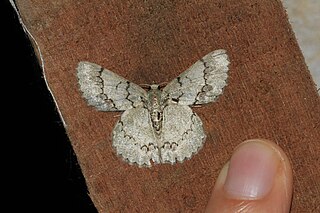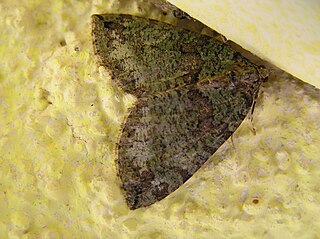
The brimstone moth is a moth of the family Geometridae. The species was first described by Carl Linnaeus in his 1758 10th edition of Systema Naturae. It should not be confused with the brimstone butterfly Gonepteryx rhamni.

Catharanthus roseus, commonly known as bright eyes, Cape periwinkle, graveyard plant, Madagascar periwinkle, old maid, pink periwinkle, rose periwinkle, is a species of flowering plant in the family Apocynaceae. It is native and endemic to Madagascar, but grown elsewhere as an ornamental and medicinal plant, a source of the drugs vincristine and vinblastine, used to treat cancer. It was formerly included in the genus Vinca as Vinca rosea.

Theria primaria, the early moth, is a moth of the family Geometridae. It is found throughout Western Europe and the South Caucasus.

Pelurga comitata, the dark spinach, is a moth of the family Geometridae. It is found throughout the Palearctic, including Europe, Siberia, the Russian Far East and northern China

Plagodis pulveraria, the barred umber, is a moth of the family Geometridae. The species was first described by Carl Linnaeus in his 1758 10th edition of Systema Naturae. It is found throughout much of the Palearctic realm from Ireland to Japan, and in the Nearctic realm (Canada).

Epipristis is a genus of moths in the family Geometridae erected by Edward Meyrick in 1888.

Hydriomena furcata, the July highflyer, is a moth of the family Geometridae. The species was first described by Carl Peter Thunberg in 1784. It is found in the Holarctic ecozone.
Epipristis minimaria is a moth of the family Geometridae described by Achille Guenée in 1858. It is found in Hainan and Yunnan provinces of China, India, Bhutan, Myanmar, Sri Lanka and Indonesia.
Epipristis transiens is a moth of the family Geometridae first described by Sterneck in 1927. It is found in the Chinese provinces of Beijing, Shanxi, Henan, Shaanxi and Ningxia.
Epipristis pullusa is a moth of the family Geometridae. It is found in China (Henan).

Epipristis nelearia is a moth of the family Geometridae first described by Achille Guenée in 1858. It is found in China, India, the north-eastern Himalaya, the Philippines, Malaysia, Indonesia and Australia.
Epipristis oxycyma is a moth of the family Geometridae first described by Edward Meyrick in 1888. It is found in Queensland, Australia.
Epipristis oxyodonta is a moth of the family Geometridae first described by Louis Beethoven Prout in 1934. It is found in Western Australia, the Northern Territory and Queensland in Australia.
Epipristis storthophora is a moth of the family Geometridae first described by Louis Beethoven Prout in 1937. It is found on Bali in Indonesia.
Epipristis rufilunata is a moth of the family Geometridae first described by William Warren in 1903. It is found on New Guinea and the Bismarck Islands.
Eupithecia apta is a moth in the family Geometridae. It is found in south-western China (Yunnan).
Eupithecia atacama is a moth in the family Geometridae. It is found in the regions of Antofagasta and Atacama in Chile. The habitat consists of the North Coast and Intermediate Desert Biotic Provinces.
Eupithecia spurcata is a moth in the family Geometridae. It is found in the regions of Araucania and Los Lagos in Chile. The habitat consists of areas ranging in height from just above sea level to about 1,350 meters in the Northern Valdivian Forest and the Valdivian Forest Biotic Provinces.
Eupithecia horismoides is a moth in the family Geometridae. It is found in the regions of Araucania and Los Lagos in Chile. The habitat consists of the Northern Valdivian Forest and Valdivian Forest Biotic provinces.
Eupithecia rosalia is a moth in the family Geometridae. It is found in the regions of Araucania and Los Lagos in Chile. The habitat consists of the Northern Valdivian Forest and Valdivian Forest biotic provinces.






